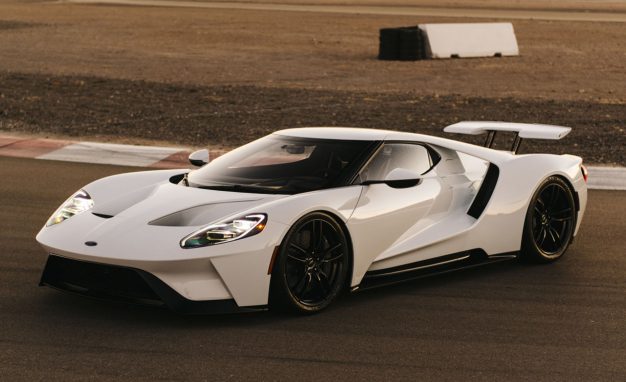Explained: The 2017 Ford GT Supercar’s Five Drive Modes

–
Ford recently made available a nearly production-ready prototype of the Ford GT supercar, during which the automaker explained how engineers tuned the car’s chassis and aerodynamic package to morph to the driver’s needs with the twist of a steering-wheel-mounted dial. Here’s an in-depth explanation of exactly what will happen when the lucky GT owner cycles through each of five modes.
–

–
Let’s start with the least aggressive setting, Wet. Here, the suspension is in Normal, its second softest setting, with 4.7 inches of ground clearance and the option to hit the Comfort button for even softer damping. Throttle response is lazier to prevent unintentional wheelspin; the ABS and stability-control systems are at their most sensitive.
–
Next up is Normal mode. The suspension, ride height, and aerodynamics are unchanged from Wet mode, but throttle response is sharper, and the stability control reins are comparatively looser. Transmission shifting strategies remain at their default.
–

–
–
One click more calls up Sport mode. The ride height stays the same, but the dampers firm up. In this mode, the GT’s anti-lag feature kicks in to manage throttle position and fuel delivery to keep the turbos spooling, eliminating lag even at low rpm. The seven-speed dual-clutch transmission adopts a more aggressive shift strategy, using accelerometers to detect spirited driving and call up the right gear for maximum thrust at corner exit. In addition, the stability control and ABS loosen their grip a bit more.
–
Up until this point, the car’s movable aerodynamic elements haven’t, well, moved. To ensure aerodynamic balance while the wing is in its stowed (and thus low-downforce) position, shutters in the nose of the car open up to allow air to bypass the downforce channels that run through the chassis via a low-pressure shunt pathway.
–

–
–
When the driver clicks into Track mode, the full aero suite is activated as the suspension drops the ride height by 2.0 inches. The shutters in the nose flip closed, diverting air entering the front of the car into the high-pressure downforce channels. The resulting front-axle downforce is balanced by the rear wing, which rises up via hydraulic actuators to act on the rear axle.
–
Other changes are going on with that rear wing. While the top surface of the wing is flat when stowed, small Gurney flaps are exposed on either side of the center brake light as the wing changes its attitude and elevates. In addition, a cam system inside the wing changes the shape of the airfoil, optimizing airflow to generate even more downforce. In Track mode, the wing also doubles as an air brake, flipping to a vertical attitude under heavy braking to increase drag.
–

–
–
The final mode, dubbed Vmax, calls up the lowered ride height and firmer damper settings of Track mode but leaves all the aero devices in their lowest drag settings—the front air shutters open up to divert airflow away from the downforce channels, and the rear wing stays in its lowered position. Raj Nair, director of product development and chief technical officer at Ford, wouldn’t directly say what kind of top speed the GT is capable of in Vmax mode, only admitting that it’s “above 200 mph.”
–
It’s worth noting how quickly these aero changes occur. Both the adjustable suspension and the rear wing actuator are powered by the GT’s old-school hydraulically assisted power-steering system. As such, everything moves with an urgency you don’t see in systems actuated via air or electric motors. Here’s a real-time demonstration in GIF form:
–

–
And another, showing how the Gurney flap extends at the rear of the wing as it elevates when switching into Track mode:
–

–
And fear not, showoffs: The rear wing still will raise up even if you haven’t dropped the car down into its super-low Track suspension setting. In Normal mode, the wing goes up at 90 mph and down at 81; in Sport mode, the wing rises at 71 and stows at 45. Even better, you can raise the rear wing to its full plumage when parked. But be warned: It’ll retract as soon as you drive off—unless you’re in Track mode.
–
–
- –
- This Is the Letter Folks Got When Their 2017 Ford GT Application Was Approved
- Here Are Some of the People Ford Accepted/Rejected for GT Ownership
- Ford GT Full Coverage: News, Photos, and More
–
–
–
–
–

–
A version of this story originally appeared on Road & Track.
–
Car and Driver BlogCar and Driver Blog
